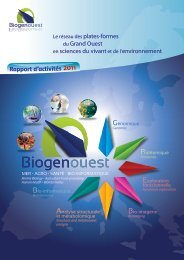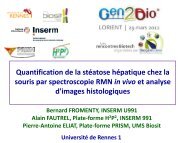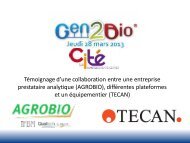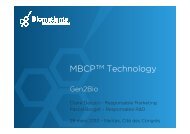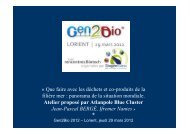Technological survey on LIMS and ELN in Life Sciences - Biogenouest
Technological survey on LIMS and ELN in Life Sciences - Biogenouest
Technological survey on LIMS and ELN in Life Sciences - Biogenouest
Create successful ePaper yourself
Turn your PDF publications into a flip-book with our unique Google optimized e-Paper software.
Introducti<strong>on</strong> 1 -‐ The European project ShareBiotech The European project ShareBiotech gathers 4 countries: Irel<strong>and</strong>, France, Spa<strong>in</strong> <strong>and</strong>Portugal. The objective of this project is to strengthen the biotechnology sector with<strong>in</strong>the Atlantic Area <strong>and</strong> improve the service offer of the technological core facilities<strong>in</strong>volved <strong>in</strong> the project. ShareBiotech notably aims at mak<strong>in</strong>g technological corefacilities more accessible to companies – <strong>and</strong> specifically small & mediumenterprises (SMEs) – work<strong>in</strong>g <strong>in</strong> the field of human health, nutriti<strong>on</strong>, agriculture/foodprocess<strong>in</strong>g,cosmetics, mar<strong>in</strong>e biology <strong>and</strong> envir<strong>on</strong>ment. Provid<strong>in</strong>g companies withtechnological service offers <strong>and</strong> carry<strong>in</strong>g out collaborative research projects will alsoc<strong>on</strong>tribute to facilitate Research & Development (R&D) projects.In 2010, ShareBiotech <strong>in</strong>itiated a technological <str<strong>on</strong>g>survey</str<strong>on</strong>g> am<strong>on</strong>gst their members(<strong>in</strong>clud<strong>in</strong>g academic laboratories <strong>and</strong> technological core facilities (1) , Biotechcompanies (2) <strong>and</strong> CROs (3) ) to identify the current technological needs. The <str<strong>on</strong>g>survey</str<strong>on</strong>g>revealed a str<strong>on</strong>g dem<strong>and</strong> <strong>in</strong> bio<strong>in</strong>formatics <strong>and</strong> more specifically the need for dataanalysis, management <strong>and</strong> storage.2 -‐ The technological needs <strong>in</strong> the <strong>Life</strong> Science market The sudden <strong>in</strong>crease <strong>in</strong> “high c<strong>on</strong>tent” technologies has created the need to structuredata management. S<strong>in</strong>ce the mid-90’s, correlated to the human genome sequenc<strong>in</strong>gachievement, “high c<strong>on</strong>tent” technologies emerged, <strong>in</strong>itially <strong>in</strong> genomics (sequenc<strong>in</strong>g,microarray, genotyp<strong>in</strong>g, SNP…) followed by proteomics (prote<strong>in</strong> identificati<strong>on</strong> <strong>on</strong> 2D-LC-MSMS, prote<strong>in</strong> microarray, biomarker identificati<strong>on</strong>…). By the year 2000, highc<strong>on</strong>tent screen<strong>in</strong>g (screen<strong>in</strong>g of milli<strong>on</strong>s of molecules <strong>on</strong> a therapeutic target of<strong>in</strong>terest) <strong>and</strong> metabolomics (metabolite identificati<strong>on</strong> us<strong>in</strong>g LS MS-MS) also requiredstr<strong>on</strong>g data management. In fact, these ultra powerful “high c<strong>on</strong>tent” technologiesgenerated massive amount of data useful <strong>in</strong> research to better underst<strong>and</strong> diseasecauses <strong>and</strong> develop new therapies. The high c<strong>on</strong>tent technologies have opened upnew perspectives to researchers <strong>and</strong> have allowed significant scientificbreakthrough.These “high c<strong>on</strong>tent” processes are usually led <strong>in</strong> partnership between academiclaboratories <strong>and</strong> <strong>in</strong>dustries. Technologies are first developed by academics <strong>and</strong> theproof of c<strong>on</strong>cept is dem<strong>on</strong>strated by academics <strong>in</strong> pilot studies. When validated, thetechnologies are transferred to the <strong>in</strong>dustry for rout<strong>in</strong>e applicati<strong>on</strong>.These technologies have <strong>in</strong>itially been applied <strong>in</strong> human health <strong>and</strong> s<strong>in</strong>ce theyprovided promis<strong>in</strong>g results, other <strong>Life</strong> Science sectors (animal health, agrofood,cosmetics, envir<strong>on</strong>ment, biologic <strong>and</strong> medical chemistry) also adopted the tools.C<strong>on</strong>sider<strong>in</strong>g the amount of data generated, data accumulati<strong>on</strong> <strong>and</strong> transfer, the data<strong>in</strong>tegrati<strong>on</strong> <strong>in</strong> the R&D process has become a bottleneck, specifically <strong>in</strong> the Pharma<strong>in</strong>dustry s<strong>in</strong>ce a reliable traceability of data is required to comply with regulati<strong>on</strong>.(1)<str<strong>on</strong>g>Technological</str<strong>on</strong>g> core facilities are structures that provide a particular type of research material (such as dataacquisiti<strong>on</strong>, data analysis, c<strong>on</strong>sultati<strong>on</strong>, <strong>and</strong>/or other service) <strong>and</strong> give access to technologies <strong>and</strong> services that aregenerally bey<strong>on</strong>d the technical or f<strong>in</strong>ancial capability of <strong>in</strong>dividual <strong>in</strong>vestigators. Often the use of these facilities isshared across departments <strong>and</strong> discipl<strong>in</strong>es.(2)A C<strong>on</strong>tract research organizati<strong>on</strong> (CRO) provides support to pharmaceutical <strong>and</strong> biotechnology <strong>in</strong>dustries asoutsourced services based <strong>on</strong> a c<strong>on</strong>tract agreement.(3)“Biotechs” st<strong>and</strong>s for biotechnologies <strong>and</strong> have for ma<strong>in</strong> activities cellular <strong>and</strong> biomolecular techniques to developproducts or services for human health care, animal health care, agricultural productivity, food process<strong>in</strong>g, renewableresources, <strong>in</strong>dustrial manufactur<strong>in</strong>g <strong>and</strong> envir<strong>on</strong>mental management.4



